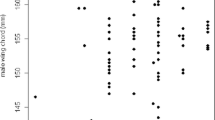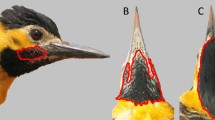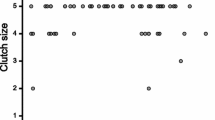Abstract
Choice of mating partners may affect fitness. Both phenotypic and genetic traits have been shown to play roles in the mating processes of animals. We investigated the roles of phenotypic and genetic characteristics in the patterns of social mating in the Silver-throated Tit (Aegithalos glaucogularis), a sexually monochromatic species that exhibits sexual size dimorphism, rarely sings, does not occupy territories, and has a relative low level of extrapair paternity. To explore the role of phenotype traits, we tested for assortative mating based on the sizes of seven morphological traits. To explore the role of genetic traits, we tested for assortative mating with respect to genetic heterozygosity (the heterozygous mate hypothesis) and whether birds mated with genetically dissimilar individuals (the compatible mate hypothesis). We found significant correlations between paired individuals for bill length and body length, indicating possible assortative mating based on these two traits. In contrast, genetic heterozygosity was not correlated between paired individuals, and the mean relatedness of the mates was not significantly different from that of randomly mated individuals, which do not support the idea that Silver-throated Tits assortatively mate with heterozygous individuals or choose genetically dissimilar mates. Also, individual heterozygosity was not reflected in the measured morphological traits, as no correlation was detected. Neither the individual heterozygosity nor the relatedness between mates was correlated with reproductive performance measures, including clutch size, brood size, and number of fledglings. However, we found that clutch size increased with female body length, which could explain the benefit to males of mating with larger females. Taken together, while our current data failed to provide evidence for an effect of genetic characteristics on the social mating pattern of Silver-throated Tits, the results suggest that phenotypic traits are likely associated with their mating pattern.
Zusammenfassung
Die Rolle phänotypischer und genetischer Eigenschaften in sozialen Paarungsmustern der Silberkehl-Schwanzmeise Die Wahl des Geschlechtspartners kann die Fitness beeinflussen. Es wurde gezeigt, dass sowohl phänotypische als auch genetische Merkmale eine Rolle spielen im Paarungsverhalten von Tieren. Wir untersuchten die Rolle von phänotypischen und genetischen Eigenschaften in den Mustern der sozialen Paarung bei der Silberkehl-Schwanzmeise (Aegithalos glaucogularis), einer Art, die zwar für die Größe, nicht jedoch für die Färbung sexualdimorph ist, selten singt, keine Territorien verteidigt und einen relativ geringen Anteil paarfremder Elternschaft aufweist. Um die Rolle phänotypischer Eigenschaften zu untersuchen, testeten wir ob anhand der Größe sieben morphologischer Merkmale zueinander passende Paare gebildet werden. Die Rolle genetischer Eigenschaften untersuchten wir, indem wir testeten, ob passende Paare in Bezug auf Heterozygotie gebildet werden (Hypothese heterozygoter Partner) und ob die Vögel sich mit genetisch weniger ähnlichen Individuen verpaaren (Hypothese kompatibler Partner). Bei verpaarten Individuen fanden wir signifikante Korrelationen zwischen Schnabellänge und Körperlänge, was auf eine Verpaarung hindeutet, die möglicherweise anhand dieser zwei Merkmale angepasst ist. Dagegen war Heterozygotie nicht korreliert zwischen verpaarten Individuen, und die mittlere genetische Verwandtschaft der Partner war nicht signifikant unterschiedlich von zufällig gepaarten Individuen. Dies spricht dagegen, dass Silberkehl-Schwanzmeisen sich gezielt mit heterozygoten Individuen verpaaren oder genetisch weniger ähnliche Partner wählen. Ebenso wenig spiegelte sich auch die individuelle Heterozygotie in den gemessenen morphologischen Eigenschaften wieder, da dort keine Korrelation gefunden werden konnte. Weder die individuelle Heterozygotie noch die Verwandtschaft zwischen den Partnern korrelierte mit Maßen für die Reproduktionsleistung, darunter Gelegegröße, Brutgröße und Anzahl der flüggen Jungtiere. Allerdings fanden wir, dass die Gelegegröße mit der Körperlänge des Weibchens zunahm, was einen Vorteil erklären könnte, die Männchen erlangen, die sich mit größeren Weibchen verpaaren. Alles in allem konnten unsere derzeitigen Daten keinen Nachweis liefern für den Einfluss genetischer Eigenschaften auf das soziale Paarungsmuster der Silberkehl-Schwanzmeisen, aber die Ergebnisse legen einen wahrscheinlichen Einfluss phänotypischer Eigenschaften nahe.



Similar content being viewed by others
References
Alho JS, Välimäki K, Merilä J (2010) Rhh: an R extension for estimating multilocus heterozygosity and heterozygosity–heterozygosity correlation. Mol Ecol Resour 10:720–722. doi:10.1111/j.1755-0998.2010.02830.x
Amos W, Wilmer JW, Fullard K, Burg T, Croxall J, Bloch D, Coulson T (2001) The influence of parental relatedness on reproductive success. Proc R Soc B 268:2021–2027. doi:10.1098/rspb.2001.1751
Andersson M (1994) Sexual selection. Princeton University Press, Princeton
Aparicio J, Ortego J, Cordero P (2006) What should we weigh to estimate heterozygosity, alleles or loci? Mol Ecol 15:4659–4665. doi:10.1111/j.1365-294X.2006.03111.x
Badyaev AV, Martin TE (2000) Sexual dimorphism in relation to current selection in the house finch. Evolution 54:987–997. doi:10.1111/j.0014-3820.2000.tb00098.x
Bennett ATD, Cuthill IC, Partridge JC, Maier EJ (1996) Ultraviolet vision and mate choice in zebra finches. Nature 380:433–435. doi:10.1038/380433a0
Blouin M, Parsons M, Lacaille V, Lotz S (1996) Use of microsatellite loci to classify individuals by relatedness. Mol Ecol 5:393–401. doi:10.1046/j.1365-294X.1996.00094.x
Brown JL (1997) A theory of mate choice based on heterozygosity. Behav Ecol 8:60–65. doi:10.1093/beheco/8.1.60
Burton NHK, Evans PR (2001) Aggressive behaviours and correlates of dominance in Purple Sandpipers Calidris maritima at a communal winter roost. Ibis 143:248–254. doi:10.1111/j.1474-919X.2001.tb04480.x
Candolin U (2003) The use of multiple cues in mate choice. Biol Rev 78:575–595. doi:10.1017/S1464793103006158
Chapman J, Nakagawa S, Coltman D, Slate J, Sheldon B (2009) A quantitative review of heterozygosity-fitness correlations in animal populations. Mol Ecol 18:2746–2765. doi:10.1111/j.1365-294X.2009.04247.x
Coltman DW, Pilkington JG, Smith JA, Pemberton JM (1999) Parasite-mediated selection against inbred Soay sheep in a free-living, island population. Evolution 53:1259–1267. doi:10.2307/2640828
Dalziell AH, Cockburn A (2008) Dawn song in superb fairy-wrens: a bird that seeks extrapair copulations during the dawn chorus. Anim Behav 75:489–500. doi:10.1016/j.anbehav.2007.05.014
Dawson D, Horsburgh G, Küpper C, Stewart I, Ball A, Durrant K, Hansson B, Bacon I, Bird S, Klein A (2010) New methods to identify conserved microsatellite loci and develop primer sets of high cross-species utility—as demonstrated for birds. Mol Ecol Resour 10:475–494. doi:10.1111/j.1755-0998.2009.02775.x
Decker KL, Conway CJ, Fontaine JJ (2012) Nest predation, food, and female age explain seasonal declines in clutch size. Evol Ecol 26:683–699. doi:10.1007/s10682-011-9521-7
Delestrade A (2001) Sexual size dimorphism and positive assortative mating in Alpine Choughs (Pyrrhocorax graculus). Auk 118:553–556. doi:10.1642/0004-8038(2001)118[0553:SSDAPA]2.0.CO;2
Duchesne P, Etienne C, Bernatchez L (2006) PERM: a computer program to detect structuring factors in social units. Mol Ecol Notes 6:965–967. doi:10.1111/j.1471-8286.2006.01414.x
Edward DA, Chapman T (2011) The evolution and significance of male mate choice. Trends Ecol Evol 26:647–654. doi:10.1016/j.tree.2011.07.012
Ferretti V, Massoni V, Bulit F, Winkler DW, Lovette IJ (2011) Heterozygosity and fitness benefits of extrapair mate choice in White-rumped Swallows (Tachycineta leucorrhoa). Behav Ecol 22:1178–1186. doi:10.1093/beheco/arr103
García-Navas V, Ortego J, Sanz JJ (2009) Heterozygosity-based assortative mating in Blue Tits (Cyanistes caeruleus): implications for the evolution of mate choice. Proc R Soc B 276:2931–2940. doi:10.1098/rspb.2009.0417
Gibson RM, Bradbury JW, Vehrencamp SL (1991) Mate choice in lekking sage grouse revisited: the roles of vocal display, female site fidelity, and copying. Behav Ecol 2:165–180. doi:10.1093/beheco/2.2.165
Griggio M, Valera F, Casas A, Pilastro A (2005) Males prefer ornamented females: a field experiment of male choice in the Rock Sparrow. Anim Behav 69:1243–1250. doi:10.1016/j.anbehav.2004.10.004
Hamann J, Cooke F (1987) Age effects on clutch size and laying dates of individual female lesser snow geese Anser caerulescens. Ibis 129:527–532. doi:10.1111/j.1474-919X.1987.tb08240.x
Harano T, Sato N, Miyatake T (2012) Effects of female and male size on female mating and remating decisions in a Bean Beetle. J Ethol 30:337–343. doi:10.1007/s10164-012-0331-3
Harari AR, Handler AM, Landolt PJ (1999) Size-assortative mating, male choice and female choice in the Curculionid Beetle Diaprepes abbreviatus. Anim Behav 58:1191–1200. doi:10.1006/anbe.1999.1257
Harrap S (2008) Family Aegithalidae (Long-tailed Tits). In: Hoyo Jd, Elliott A, Christie DA (eds) Handbook of the birds of the world, vol 13. Lynx Editions, Barcelona, pp 76–101
Hasegawa M, Arai E, Watanabe M, Nakamura M (2012) Female mate choice based on territory quality in Barn Swallows. J Ethol 30:143–150. doi:10.1007/s10164-011-0307-8
Hatchwell BJ, Ross DJ, Fowlie MK, McGowan A (2001) Kin discrimination in cooperatively breeding Long-tailed Tits. Proc R Soc B 268:885–890. doi:10.1098/rspb.2001.1598
Hettyey A, Hegyi G, Puurtinen M, Hoi H, Török J, Penn DJ (2010) Mate choice for genetic benefits: time to put the pieces together. Ethology 116:1–9. doi:10.1111/j.1439-0310.2009.01704.x
Hoffman J, Forcada J, Trathan P, Amos W (2007) Female fur seals show active choice for males that are heterozygous and unrelated. Nature 445:912–914. doi:10.1038/nature05558
Holveck M-J, Geberzahn N, Riebel K (2011) An experimental test of condition-dependent male and female mate choice in Zebra Finches. PLoS One 6:e23974. doi:10.1371/journal.pone.0023974
Jiang Y, Bolnick DI, Kirkpatrick M (2013) Assortative mating in animals. Am Nat 181:E125–E138. doi:10.1086/670160
Johannesson K, Rolan-Alvarez E, Ekendahl A (1995) Incipient reproductive isolation between two sympatric morphs of the Intertidal Snail Littorina saxatilis. Evolution 49:1180–1190. doi:10.2307/2410443
Jones KM, Monaghan P, Nager RG (2001) Male mate choice and female fecundity in Zebra Finches. Anim Behav 62:1021–1026. doi:10.1006/anbe.2001.1843
Kalinowski ST, Wagner AP, Taper ML (2006) ML-RELATE: a computer program for maximum likelihood estimation of relatedness and relationship. Mol Ecol Notes 6:576–579. doi:10.1111/j.1471-8286.2006.01256.x
Kempenaers B (2007) Mate choice and genetic quality: a review of the heterozygosity theory. Adv Study Behav 37:189–278
Kleven O, Lifjeld JT (2005) No evidence for increased offspring heterozygosity from extra-pair mating in the Reed Bunting (Emberiza schoeniclus). Behav Ecol 16:561–565. doi:10.1093/beheco/ari027
Kotiaho JS, LeBas NR, Puurtinen M, Tomkins JL (2008) On the resolution of the lek paradox. Trends Ecol Evol 23:1–3. doi:10.1016/j.tree.2007.09.012
Li J, Wang N, Wang Y, Lin S, Li Q, Liu Y, Ruan X, Zhu J, Xi B, Zhang Z (2010) Sexual size dimorphism and sex identification using morphological traits of two Aegithalidae species. Zool Sci 27:946–951. doi:10.2108/zsj.27.946
Li J, Lv L, Wang Y, Xi B, Zhang Z (2012) Breeding biology of two sympatric Aegithalos tits with helpers at the nest. J Ornithol 153:273–283. doi:10.1007/s10336-011-0740-z
Li J, Liu Y, Wang Y, Zhang Z (2014) Extra-pair paternity in two sympatric Aegithalos tits: patterns and implications. J Ornithol 155:83–90. doi:10.1007/s10336-013-0989-5
Ljungqvist M, Åkesson M, Hansson B (2010) Do microsatellites reflect genome-wide genetic diversity in natural populations? A comment on Väli et al. (2008). Mol Ecol 19:851–855. doi:10.1111/j.1365-294X.2010.04522.x
Mays HL, Hill GE (2004) Choosing mates: good genes versus genes that are a good fit. Trends Ecol Evol 19:554–559. doi:10.1016/j.tree.2004.07.018
Mulard H, Danchin E, Talbot SL, Ramey AM, Hatch SA, White JF, Helfenstein F, Wagner RH (2009) Evidence that pairing with genetically similar mates is maladaptive in a monogamous bird. BMC Evol Biol 9:147. doi:10.1186/1471-2148-9-147
Neff BD, Pitcher TE (2005) Genetic quality and sexual selection: an integrated framework for good genes and compatible genes. Mol Ecol 14:19–38. doi:10.1111/j.1365-294X.2004.02395.x
Olsson M (1993) Male preference for large females and assortative mating for body size in the Sand Lizard (Lacerta agilis). Behav Ecol Socio Biol 32:337–341. doi:10.1007/BF00183789
Ortego J, Calabuig G, Bonal R, Muñoz A, Aparicio JM, Cordero P (2009) Temporal variation of heterozygosity-based assortative mating and related benefits in a Lesser Kestrel population. J Evol Biol 22:2488–2495. doi:10.1111/j.1420-9101.2009.01865.x
Pack AA, Herman LM, Spitz SS, Craig AS, Hakala S, Deakos MH, Herman EYK, Milette AJ, Carroll E, Levitt S (2012) Size-assortative pairing and discrimination of potential mates by Humpback Whales in the Hawaiian breeding grounds. Anim Behav 84:983–993. doi:10.1016/j.anbehav.2012.07.024
Päckert M, Martens J, Sun Y-H (2010) Phylogeny of Long-tailed Tits and allies inferred from mitochondrial and nuclear markers (Aves: Passeriformes, Aegithalidae). Mol Phylogenet Evol 55:952–967. doi:10.1016/j.ympev.2010.01.024
Pusey AE (1987) Sex-biased dispersal and inbreeding avoidance in birds and mammals. Trends Ecol Evol 2:295–299. doi:10.1016/0169-5347(87)90081-4
Pusey A, Wolf M (1996) Inbreeding avoidance in animals. Trends Ecol Evol 11:201–206. doi:10.1016/0169-5347(96)10028-8
Puurtinen M, Ketola T, Kotiaho J (2009) The good-genes and compatible-genes benefits of mate choice. Am Nat 174:741–752. doi:10.1086/606024
R Core Team (2012) R: a language and environment for statistical computing. R Foundation for Statistical Computing, Vienna. http://www.R-project.org/. Accessed Oct 2012
Radford AN, Du Plessis MA (2003) Bill dimorphism and foraging niche partitioning in the Green Wood Hoopoe. J Anim Ecol 72:258–269. doi:10.1046/j.1365-2656.2003.00697.x
Richner H (1989) Phenotypic correlates of dominance in Carrion Crows and their effects on access to food. Anim Behav 38:606–612. doi:10.1016/S0003-3472(89)80005-3
Rubenstein DR (2007) Female extra-pair mate choice in a cooperative breeder: trading sex for help and increasing offspring heterozygosity. Proc R Soc B 274:1895–1903. doi:10.1098/rspb.2007.0424
Russell AF (2001) Dispersal costs set the scene for helping in an atypical avian cooperative breeder. Proc R Soc B 268:95–99. doi:10.1098/rspb.2000.1335
Ryder T, Tori W, Blake J, Loiselle B, Parker P (2010) Mate choice for genetic quality: a test of the heterozygosity and compatibility hypotheses in a lek-breeding bird. Behav Ecol 21:203–210. doi:10.1093/beheco/arp176
Searcy WA (1979) Morphological correlates of dominance in captive male Red-Winged Blackbirds. Condor 81:417–420. doi:10.2307/1366971
Seddon N, Amos W, Mulder RA, Tobias JA (2004) Male heterozygosity predicts territory size, song structure and reproductive success in a cooperatively breeding bird. Proc R Soc B 271:1823–1829. doi:10.1098/rspb.2004.2805
Sharp SP, McGowan A, Wood MJ, Hatchwell BJ (2005) Learned kin recognition cues in a social bird. Nature 434:1127–1130. doi:10.1038/nature03522
Sharp SP, Baker MB, Hadfield JD, Simeoni M, Hatchwell BJ (2008) Natal dispersal and recruitment in a cooperatively breeding bird. Oikos 117:1371–1379. doi:10.1111/j.2008.0030-1299.16392.x
Simeoni M, Dawson DA, Ross DJ, Chaline N, Burke T, Hatchwell BJ (2007) Characterization of 20 microsatellite loci in the Long-tailed Tit Aegithalos caudatus (Aegithalidae, Aves). Mol Ecol Notes 7:1319–1322. doi:10.1111/j.1471-8286.2007.01868.x
Stapleton MK, Kleven O, Lifjeld JT, Robertson RJ (2007) Female Tree Swallows (Tachycineta bicolor) increase offspring heterozygosity through extra-pair mating. Behav Ecol Sociobiol 61:1725–1733. doi:10.1007/s00265-007-0404-4
Suter SM, Keiser M, Feignoux R, Meyer DR (2007) Reed Bunting females increase fitness through extra-pair mating with genetically dissimilar males. Proc R Soc B 274:2865–2871. doi:10.1098/rspb.2007.0799
Taborsky B, Guyer L, Taborsky M (2009) Size-assortative mating in the absence of mate choice. Anim Behav 77:439–448. doi:10.1016/j.anbehav.2008.10.020
Toomey MB, McGraw KJ (2012) Mate choice for a male carotenoid-based ornament is linked to female dietary carotenoid intake and accumulation. BMC Evol Biol 12:3. doi:10.1186/1471-2148-12-3
Torres R, Velando A (2005) Male preference for female foot colour in the socially monogamous Blue-footed Booby, Sula nebouxii. Anim Behav 69:59–65. doi:10.1016/j.anbehav.2004.03.008
Trivers R (1972) Parental investment and sexual selection. In: Campbell B (ed) Sexual selection and the descent of man 1871–1971. Aldine, Chicago, pp 136–179
Väli Ü, Einarsson A, Waits L, Ellegren H (2008) To what extent do microsatellite markers reflect genome-wide genetic diversity in natural populations? Mol Ecol 17:3808–3817. doi:10.1111/j.1365-294X.2008.03876.x
Varian-Ramos CW, Webster MS (2012) Extra-pair copulations reduce inbreeding for female Red-backed Fairy-wrens, Malurus melanocephalus. Anim Behav 83:857–864. doi:10.1016/j.anbehav.2012.01.010
Verrell PA (1995) Males choose larger females as mates in the Salamander Desmognathus santeetlah. Ethology 99:162–171. doi:10.1111/j.1439-0310.1995.tb01097.x
Wagner RH (1999) Sexual size dimorphism and assortative mating in Razorbills (Alca torda). Auk 116:542–544. doi:10.2307/4089388
Wang N, Li J, Liu Y, Zhang Z (2010) Improvement on molecular sex identification primers for Passeriform bird species. Chin Birds 1:65–69. doi:10.5122/cbirds.2009.0009
Acknowledgments
Financial support of the study was provided by the National Natural Science Foundation of China (Nos. 31101644 and 31470221), and a USDA Evens-Allen grant through Alabama A&M University. Yong Wang’s research in China was supported by funds from Alabama A&M University, the US National Science Foundation, and Beijing Normal University. We thank Myung-Bok Lee, Abel Souriau, Zachary Pohlen, Gabriele Cavallini, Edmund Keyes, Kai-Ting Yang, Peng Zhang, Jiao Wang, Chang Gao, Lijv Chen, Xiaolong Wu, and Yingying Liu for their valuable help with the field or lab work. We also thank Dongzhai National Reserve for giving us permission to perform and assistance with our fieldwork. We are most grateful to Andrew Cantrell, Yang Liu and two anonymous reviewers for their constructive comments on the manuscript. Our study abided by the current laws of China on the protection of wildlife.
Conflict of interest
The authors declare that they have no conflict of interest.
Author information
Authors and Affiliations
Corresponding author
Additional information
Communicated by M. Wink.
Rights and permissions
About this article
Cite this article
Li, J., Lv, L., Wang, P. et al. Roles of phenotypic and genetic characteristics in the social mating pattern of Silver-throated Tits (Aegithalos glaucogularis). J Ornithol 156, 687–697 (2015). https://doi.org/10.1007/s10336-015-1166-9
Received:
Revised:
Accepted:
Published:
Issue Date:
DOI: https://doi.org/10.1007/s10336-015-1166-9




